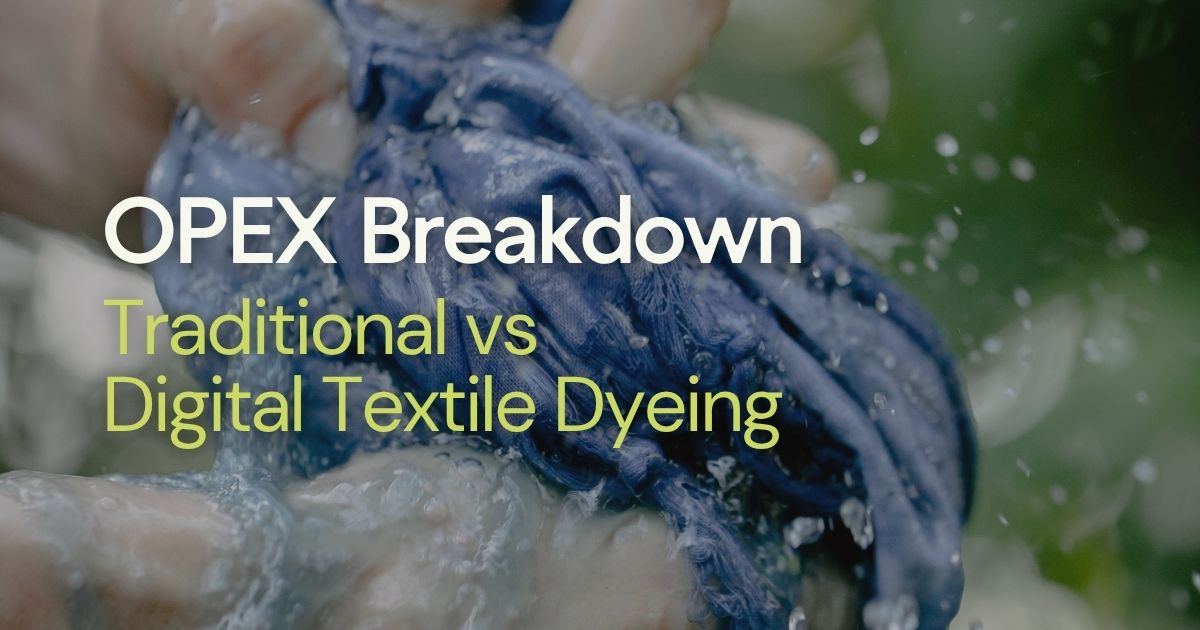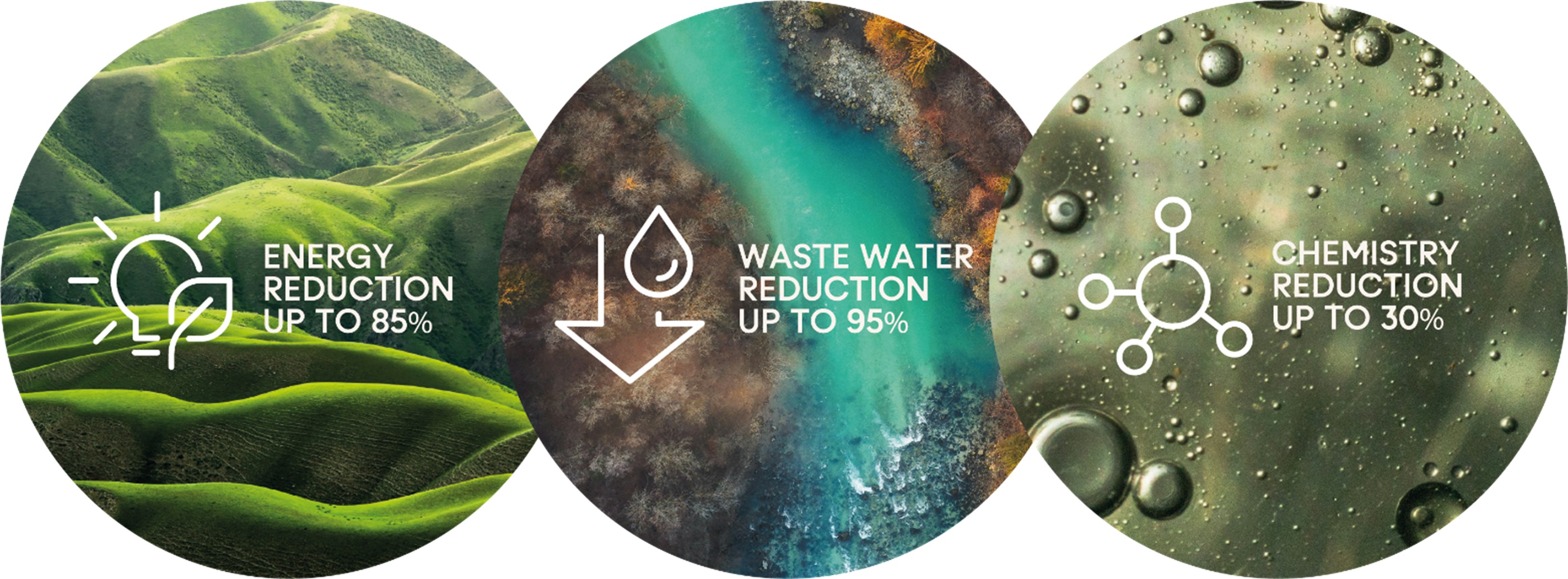
Fabric colouration has been a cornerstone of the textiles industry for centuries. With traditional dyeing methods such as jet exhaust dyeing and dye baths defining how colours are added to our clothes and home textiles. These methods have served us well, but their environmental and operational costs have been increasingly questioned over the years. With rising costs around the world and demand for ethical textile production on the rise, the textile industry is shifting from traditional to digital textile dyeing as a more efficient and profitable way to dye textiles.
What is OPEX and Why it’s Important
Operational expenditure (OPEX) refers to the ongoing costs that are required to run day-to-day business operations. In the textile industry, this includes expenses such as water and energy consumption, chemical usage, and labour – directly affecting a company’s cash flow and profitability on a recurring basis. In resource-intensive processes like traditional textile dyeing, high OPEX can significantly erode profit margins, especially as utility prices fluctuate and regulatory pressures increase.
For brands, textile manufacturers, and stakeholders across the supply chain, understanding and optimising OPEX is critical. Reducing operational costs without compromising on quality enables you to remain competitive, strengthen supply chain resilience, and improve return on investments.
Reducing your OPEX also benefits your sustainability credentials. With sustainability becoming a non-negotiable expectation from consumers and regulators alike, lowering OPEX through clean-tech innovations. For example, digital textile dyeing which can help you meet environmental goals. Today, controlling OPEX is not just a financial necessity, it’s a strategic move towards a more sustainable and profitable future of textiles.
Traditional Textile Dyeing OPEX Breakdown
Traditional textile dyeing methods are resource-intensive, labour-dependent, and environmentally harmful. These outdated processes pose modern problems for textile manufacturers, balancing environmental impact against soaring operational expenditure (OPEX).
Overreliance on Water and Chemicals
Traditional textile dyeing relies heavily on water. Jet exhaust dyeing, for example, immerses fabric in large vessels of water mixed with dye and fixatives. This method alone can waste up to 93 billion cubic metres of water annually, enough to fill almost 37 million Olympic-sized swimming pools. Demonstrating that not only is water use extortionate, but it drives up both the cost of water procurement and the cost of wastewater treatment for textile manufacturers.
As for wastewater, this is produced when combining chemicals and fixatives to water during the textile dyeing process. Due to high water use, naturally more wastewater is emitted. Leading to higher water bills and expensive wastewater treatment systems. These treatment systems are designed to process the metals, salts, and toxic dyes that are in wastewater which would degrade water quality if left untreated. Therefore, the industry’s overreliance on water and chemicals add significantly to textile manufacturers’ OPEX and can cause long-term environmental damage.
Costly Energy Consumption
Heating massive volumes of water for extended periods in traditional textile dyeing methods can reach temperatures as high as 135°C (275°F). This costly energy consumption is often delivered by burning fossil fuels. Whether it’s via direct gas heating, steam injection, or industrial heaters, these processes are causing greenhouse gas emissions to soar (Global Fashion Agenda, 2018). Resulting in volatile and high energy bills. So, considering that global energy prices remain high and carbon taxes or emissions-related fees continue to be implemented, these energy-intensive methods are no longer sustainable – becoming increasingly expensive and directly impacting your bottom line.
Labour-Intensive Operations
From managing vessels to overseeing dye baths, traditional textile dyeing requires constant manual oversight, machine operation, and quality checks, often across multiple shifts. The need for skilled workers to manage traditional dyeing methods, monitor temperatures, and correcting inconsistencies which also impacts production timelines and add up to significant recurring expenses.
Although the number of people needed to man traditional dyeing methods vary, as does the hourly rate of pay for textile factory workers per country. Ranging from $3/hour in South America and South East Asia to $8/hour in parts of Europe. As wages continue to rise globally and reprocessing due to colour variation becomes more common, labour-intensive operations increase both direct and indirect operational costs.
Digital Textile Dyeing OPEX Opportunities
The good news? High OPEX doesn’t have to be part of the equation. Clean-tech innovations such as digital textile dyeing are presenting new OPEX opportunities for brands, textile manufacturers, and stakeholders across the supply chain.
We at Alchemie Technology are reshaping how the industry approaches fabric colouration to by providing clean-tech, digital textile dyeing solutions like Endeavour™.
✅ Fully electric system
✅ Digitally controlled nanolitre droplet dye application
✅ No dye baths or excess rinse cycles
✅ Exceptional colour penetration, uniformity, and fastness
✅ Modular system design, suitable for scaling production
Traditional vs Digital Textile Dyeing
Alchemie’s solutions offer a transformative opportunity to reduce OPEX by addressing the core inefficiencies of traditional textile dyeing. Unlike water-intensive, energy-hungry, and labour-dependent methods, Endeavour™ uses clean-tech digital precision to apply dye directly to fabrics in controlled nanolitre droplets – without the need for dye baths or excessive rinsing. Capable of cutting water usage by up to 95% and saving you on water procurement and wastewater treatment costs.
As a fully electric system, Endeavour™ slashes energy consumption and eliminates fossil fuel dependency – reducing energy-related consumption by up to 85%. With digital control and automation, Endeavour™ lowers labour requirements by up to 60%, reducing reliance on manual oversight and minimising costly reprocessing due to colour inconsistencies. Altogether brands, textile manufacturers, and stakeholders across the industry can achieve up to 50% OPEX savings, while aligning with sustainability goals. Future-proofing operations in a more resource-efficient and regulatory compliant way, without compromising on quality of colour, uniformity, or fastness.
 Conclusion for the Future of Textiles
Conclusion for the Future of Textiles
For too long the fashion industry has embraced vibrant colour without tackling its hidden costs. From water depletion and toxic pollution to excessive energy use, the environmental and operational costs of traditional textile dyeing are becoming harder to ignore.
Today, the combination of high energy prices, water scarcity, and labour expenses makes traditional dyeing methods outdated and unsustainable. Forward-thinking brands and textile manufacturers that adopt clean-tech solutions now are positioning themselves as leaders in more sustainable textile manufacturing, aligning with the growing global narrative of environmentally responsible textile dyeing.
Alchemie’s Endeavour™ system offers a transformative step forward for textile dyeing. By cutting water usage by up to 95%, you can save on the high costs of water procurement and treatment. As a fully electric system, Endeavour™ reduces energy consumption by up to 85%, freeing manufacturers from volatile traditional dyeing methods and fossil fuels prices. With automated digital precision, Endeavour™ lowers labour dependency by up to 60%, streamlining production while improving colour accuracy and consistency. Together, these result in Endeavour™ delivering up to 50% OPEX savings – proving that sustainability and profitability are no longer opposites, but rather equal drivers of a smarter, cleaner, and more resilient future of textiles.
Want to lower your OPEX and transition to more sustainable, profitable textile dyeing? Then contact us at enquiries@alchemietechnology.com.